Development of new wingsail designs continues at Solid Wing Sails here in Punta Gorda, with the latest versions designed to work on Laser sailboats. Inventor Chuck Taylor decided that the 2014 Charlotte Harbor Regatta would be a good event to test and demonstrate the new wings and entered three Lasers in the races. The Laser Masters event was held concurrently with last year's Charlotte Harbor Regatta and there were about 100 Lasers on the starting line. The hope was that at least a few would show up this year so that we could evaluate the performance of the wingsails against traditional sails in a racing setting.
Alas, no other Lasers entered the event, but the organizers decided to give us a Laser Class start anyway using Chuck's three boats. We decided that since only wingsail boats were participating, and since no one in the world had previously raced wingsail Lasers, this must be the inaugural Wingsail Laser World Championships! There was no one around to stop us from calling it that, so we did.
Two of three boats were ready to go on Saturday, with the third wing not quite finished. We arrived at the Punta Gorda Bayfront Center a bit late and were unloading and assembling boats and wings as Sun Herald reporter Al Hemingway interviewed Chuck about his wing development.
At left, Bob Hill is assembling wing sections. The two wing sections are bolted together on the ground, then we tilt the boat on its side to insert the wing into the mast step. This is most easily accomplished by three people: one to hold the boat and two to align and insert the wing. The assembled wing weighs only 18 lbs in this configuration. The post-regatta redesign weighs even less, but more about that later.

Here is a picture of the two wingsail-equipped Lasers after we stepped the masts. The one on the right appears to have a telephone pole growing out the top of the mast. I need to pay more attention to the background when I take pictures! As usual, a curious onlooker has approached to ask about these newfangled sails we are using. Note for the future: factor question and answer time into our setup time calculations.
This shot of the cockpit of the boat I was sailing shows the wing sail controls we were using. This design was meant to overcome a problem we experienced with previous iterations. To tack the wingsail-equipped Hobie Bravo, for example, it was necessary to steer the boat with one hand, work the mainsheet with the other hand, and simultaneously work the wing slot controls with the other hand, all while moving from one side of the boat to the other and switching hands on the controls. Those familiar with human anatomy see the obvious problem!
The new controls were meant to retain wing slot adjustment while allowing the rear wing section to flip to the other tack automatically. This would leave the sailor free to operate only the sheet and tiller when tacking, as with a conventional rig. It was accomplished by creating a parallelogram composed of T-shaped arms joined by aluminum bars, with the forward T-arm joined to an identical one below by a carbon fiber tube. The lower T-arm has two control lines led to cam cleats mounted on a plate secured to the deck. The control lines allow adjustment of the the size of the slot between the wing sections. The control system was meant to be self-tacking, and it was, which was a marked improvement over the previous system, but adjustment of the slot size was still necessary after the tack.

Our tardy arrival was somewhat mitigated by fog over the harbor, delaying the start of racing for an hour or so, but by the time we got our boats in the water, the rest of the small boat fleets of Sunfish, Flying Scots, and Precision 15's were already out on the course. Thanks to our tireless promoter of local sailing, Sarah Buck, for sharing this picture of me taken as I was getting the boat out. The race committee and other boats are out there in the fog someplace.
My friend Don showed up in his prototype Extra Light Boat that we affectionately call the Cowmaran to help us set up and to act as a photo boat and safety boat for the Wingsail Laser fleet. The race committee, of course, had safety boats out on the course, but when racing experimental prototypes, the likelihood of actually needing one is substantially higher. It was nice to have Don's help on the water and off and many of the pictures that follow are his, so thanks, Don!

Heading out to the race course, I did not get very far. I'm not sure what caused it, but as I was sailing along in very light wind, the carbon fiber column connecting the upper and lower control arms separated from the lower one, leaving me with no good control over the wing slot. I turned around, thinking I was probably done for the day, but Chuck had another control column assembly on hand and we swapped them out.
As I approached the racing area, Bob was sailing toward me in the other wingsail Laser. I figured it was time for another pre-race mutual taunting session, but he was not coming my way for the fun of it. He had broken his mast step and was heading back to shore! His mast was askew, but I had not noticed it initially because wing sails look kind of strange anyway. I sailed over toward the Cowmaran and informed Don that Bob would need a tow back to the ramp.
Sailing around on the edges of the fleet as the other small boat classes prepared to start another race, I took the opportunity to experiment with the new wing and its controls. With little experience sailing Lasers or boats with wings, I was sort of stumbling around blindly trying to find what worked. I found that the size of the slot between the wings is very important. If the slot is too small or too large, the wing has little power, but get it right and it has surprising power! In the picture at right, I have the wing sections aligned with one another and virtually no slot since I was stopping the boat to take the picture. Opening the slot back up got me moving toward the fleet again.
I did not believe at the time that Bob would be back out to race and was wondering whether I should bother the race committee with an Experimental Wingsail Laser class consisting of one boat, but before too long I spotted Bob sailing back out toward me. It turned out that his mast step was not broken. The aluminum section that is inserted into the wing and into the boat had worked its way out of the socket inside the boat. They plugged it back in and he was back in business. He arrived as the last of the other fleets started and the race committee called us over for our start.
We completed one race and Bob won. I was just glad to get around the course! It turned out that bearing off at the upwind mark, usually a pretty simple matter, was a rather tricky move with this control setup. I felt like I was just starting to learn how to control the boat by the end of the race. The second race was a bit more interesting...

Bob got off to a better start in race two than I did, crossing the line a good ten seconds in front of me, but he sailed into a calm spot and I saw his boat slowing down as I was passing the race committee boat. Not knowing whether I would make it, I decided to tack close to the bow of the RC boat. As I reset the slot on the new tack, I could feel the wing power up and saw that I would clear the RC boat's anchor rode without any trouble. Hey, I like this new wing!!
Bob was quick to notice that I was still moving while he was not, so he tacked over in my direction just before the picture at right was taken, but there was still less wind in his area and the wakes show that my boat was moving while his was not. Despite being late to the starting line, I had a good shot at beating Bob to the windward mark.
Bob escaped the patch of doldrums and came charging upwind after me. When I was sure I had the windward mark made, I tacked toward it and crossed his bow. Foreshortening from the camera makes it appear we were closer than we actually were at this point, but it was plenty close enough for some good mutual taunting.
We both had quite a bit of trouble rounding the mark and heading back downwind. In my case, I decided to try letting the wing out far in front of the boat to see whether I could get it to lift the boat downwind, rather than using it as essentially a flat plate. The results were disastrous and comical. With the wing swung around to the forward side of the mast step, my control lines did not work right any more. In trying to get them to work, I managed to let the wing swing all the way around from one side to the other of the front of the boat. That wrapped my control lines and mainsheet around the mast step, at which point they went from not working right to not working at all. The only way I could think of to get myself out of this situation was to turn the boat and try to sail it back underneath the proper side of the wing. As I started that turn, the wing suddenly caught some air and started pushing the boat. Unfortunately, it was out in front of me and started pushing me backwards, stopping the boat. Oops. I finally got the wing back where it belonged and decided it might be prudent to just sail it downwind like a square-rigger.
I figured that Bob would take advantage of my mistakes and get around me, but he had his own problems coming around the mark, similar in nature to the beginning of my troubles. As he eased the sail out, the wing slot flopped in the wrong direction, and because the sail was perpendicular to the boat, the slot control lines were both aligned fore and aft, rendering them ineffective. In the course of getting it sorted out, he managed to break the control T-arm free from its carbon fiber tube, just as I had done earlier in the day. This left him without any good control over the slot, but he still managed to pass me going downwind.

The picture at right shows the problem Bob was having. In order to power up his wing, he had to lean over to the downwind side of the boat, but if he leaned that way and powered up enough, the boat would capsize. In the foreground, I was able to use my weight to keep the boat level. My mainsheet was cleated beside me and I kept the slot control line in my hand. I'm not sure whether that is proper wing sailing technique or not, but it seemed to be working better than cleating off the slot control and adjusting power with the sheet. Racing a small boat without my hand on the mainsheet goes against all my life's experience, but I had my hand on the main thing that seemed to be controlling the power of the sail. Bob did too, but he did not really have a choice in the matter at that point!
I got around the upwind mark with a pretty good lead on Bob, and this time made a smoother transition into downwind square-rigger mode. Bob once again managed to chase me down on the run back toward the finish line. I think he was going faster downwind because he owns a Laser and knows where to sit and how to drive it downwind and because when fully "closed" the slot on my wing was a bit wider than the one on his wing. Essentially, we were racing square riggers with big, vertical rips in the sails, but mine was ripped a little worse.
As we approached the finish, Bob was having a good time as leeward boat trying to force me into the race committee boat. I let him get a little too close at one point and as our boats rolled on waves, the mast tips touched. My mind immediately went to the fiasco that was likely to ensue: attempting penalty turns with this unfamiliar rig was likely to go horribly wrong, possibly breaking something, after which my disabled boat would drift down onto the bow pulpit of the committee boat, taking out the remains of the rig. While all this was happening, Bob would sail across the finish line laughing, at least until the sounds of carbon fiber shattering overpowered his laugh.

I decided that it would be better to just go the wrong way around the committee boat and take a DNF (Did Not Finish) instead of second place in the race. The Race Committee is not supposed to help the racers, but I guess one of them took pity on my obvious cluelessness, and I heard him say, "You have to go around the committee boat the other way to finish!"
"Thank you," I said, and sailed on back toward the ramp.
We had a nice breeze as we headed in and I got to experiment some more with slot control on a reach. Wow! That thing is powerful! I was looking forward to racing it some more the next day.

Chuck spent a good part of that day and night over at the Solid Wing Sails shop completing the third Laser wing so that he could race with us on Sunday. This wing has a rounded trailing edge on the aft section, which I think looks a lot nicer than the angular trailing edges on the XL1 and XL2 wings that Bob and I were using. At right, Bob is unloading the forward wing section from its transport rack.
Don once again came over with the Cowmaran and in the photo at left is watching as Chuck and a helpful guy from the neighborhood finish assembling wing controls. He was one of two people from the neighborhood who ran home and got tools to help us out. Thanks, neighbors!

We were late arriving at the starting area, but still had time to get in some racing. Don took the picture at right showing Chuck sailing XL3, me sailing XL1, and a Flying Scot finishing a race in the background. With more wind than the day before, I was looking forward to seeing what these wings could do!
I was making good time around the race course and had lost track of where Chuck and Bob were because I was pretty far ahead of them. I came across Bob at one point and he expressed frustration that he was having trouble getting his boat moving. I think it was mostly because I had chosen the left side of the course while he went right and the wind happened to be better where I was.
I was feeling pretty good about my imminent victory when movement at the mast step caught my eye. I was going over some waves, and with each one, the mast was rising up just a little bit.
Uh oh, I thought, that can't go on for much longer before it comes up out of the...
CRACK! Crunch!
...uh, yeah, the mast step. My mast had come up out of the step, much as Bob's had done the day before, or so I thought.
What followed would have been pretty hilarious if captured on video. Abandoning the tiller, I rushed forward and grabbed the rig, trying to right it and stuff the spar back into the socket. This was doomed to fail because the step/socket inside the boat was what had made the loud cracking sound, but I could not see it and did not know that at the time.
Trying to wrestle the wing, I latched onto one of the control T-arms and broke it off. Meanwhile, the boat reacted to my inattention by spinning in a circle, wrapping the mainsheet and control lines around the front of the mast. I decided it was time to get as many pieces back to shore intact as possible and headed for home. In the shot at left, I'm holding the part of the mainsheet that I could reach to power up the sail. It worked surprisingly well!
The picture was taken by Don from the Cowmaran, who naturally offered me a tow when he saw my predicament, but I thought that the steady pressure of sailing on the rig would be easier on it than bouncing around under tow, so I declined. I asked him to follow me, just in case the wing fell the rest of the way into the water, but that did not happen until I was back at the ramp.
The parallelogram control system we were using was an improvement on the previous designs, but it had some serious flaws. It was complicated, with a lot of pieces to create friction. It was bulky, with pieces that could snag a line or life jacket, and did. It was also fragile, with lots of ways to damage the control arms during assembly and launching. The aluminum bars were light enough that they bent instead of adjusting the slot at times, though we were not sure whether having the shock absorption inherent in flexible material might actually be an advantage.

In any case, the whole system has been abandoned and Chuck wasted no time in coming up with a new slot control design. He called me on Monday, wanting to meet on Tuesday to discuss it. We could not meet Tuesday because Dennis Peck was unavailable, so we met up with Dennis and Bob on Wednesday over at the Charlotte Harbor Community Sailing Center.
The new control looked to me to be a bit too simple to actually work. Chuck took an old wing rib and bolted it to the bottom of the aft wing section with the narrow end facing forward. A line leads from the end to a block at the mast, where it turns back toward the cockpit. They wanted to put it in the water and try it out, but I could not see how it could possibly open the slot. Close it, sure, but what if you want it open?
I suggested that we "dry sail" the rig a bit by just spinning the boat around on the grass to different points of sail. We found that the mainsheet tends to open the slot a bit, but not enough. The new control worked fine at closing the slot. I suggested moving the mainsheet block further aft on the wing section, so that pulling it would tend to open up the slot more than desired. That way, a control that was only good at closing the slot is all that is needed.
Dennis pointed out that if we moved it too far aft, the mainsheet would tend to tip the mast forward when sheeted hard, possibly causing damage, but if we moved it a bit less than I was suggesting, it should work. We had learned what we came to learn about the new design, but Dennis still wanted to put the boat in the water. He knew the wing would not care whether grass or water was under the hull, but wanted to try it out anyway.
You can't keep the guy on shore! In the picture at right, the wing is performing pretty well, but would do better with the slot open a bit wider. Shortly after I took that picture, Chuck and I both watched as Dennis reached over, grabbed the wing, and manually opened the slot a bit. The boat took off, just as we thought it would. He abruptly turned around and headed back to the dock. When he got there, he said he had heard something crack and thought he might have a problem up where the tops of the wing sections are attached. When we were taking it apart, no damage was found up top, but the tip of the center rib in the wing had cracked, deforming the trailing edge.
I'm looking forward to trying out the new wing control once Chuck moves the mainsheet attachment aft. I think it will work far better than the previous version and do it with a lot fewer pieces, less weight, and less complexity.

Update: February 18, 2014
New Control System Test
I got to the beach just in time to see Dennis sailing out to test the latest wing slot control system. I brought the Klepper kayak as a photo boat today and quickly set out after him.
By the time I got out into Alligator Bay, Dennis was coming downwind. We experimented with letting the wing way out and opening the slot wide. It seemed to work in the very light wind.

I shot a little bit of video of the new sail, including one showing how it self-adjusts when tacking. At least, it would if there were a bit more wind!

The new wing control system worked very well as long as the wind held out, then I wound up towing Dennis back to the beach when the wind died. In the photo at right, the slot control line is pulled tight to close the slot. The mainsheet is attached to the aft wing section just out of the picture, so pressure on the sail tends to open the slot. At the mast base is a control arm with block and cam cleat that rotates toward the sailor when the slot control line is pulled, making it easy to cleat off or release when hiking out.
At left is a picture of the wing slot with the control line loosened and the slot open. The mainsheet attachment point is visible just aft of the control arm.
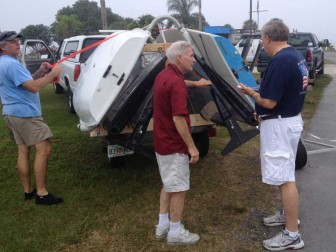
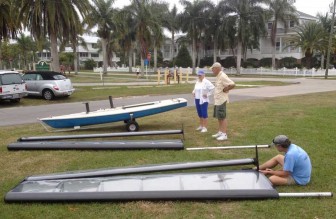

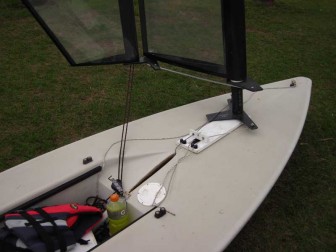
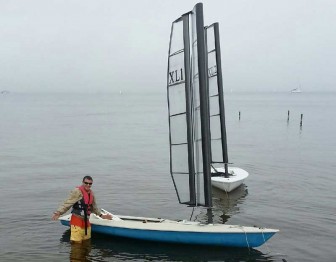
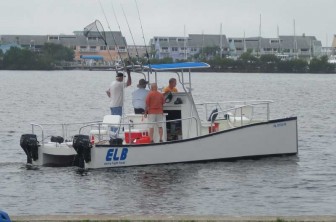
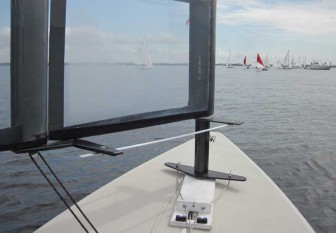
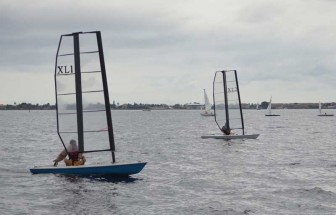
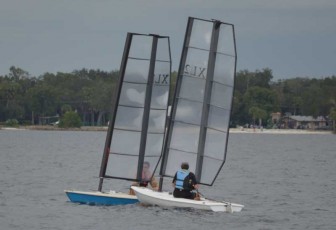
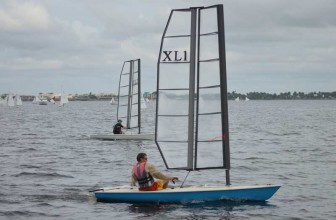
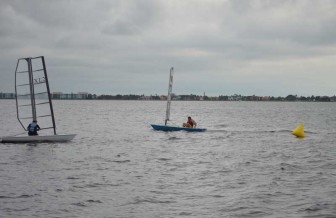
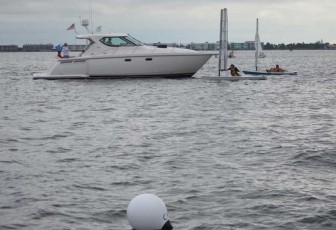
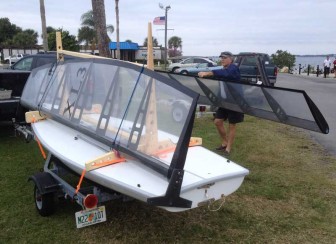
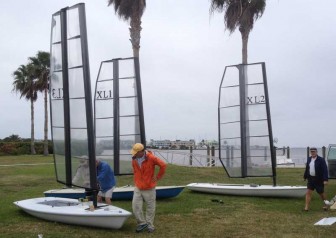
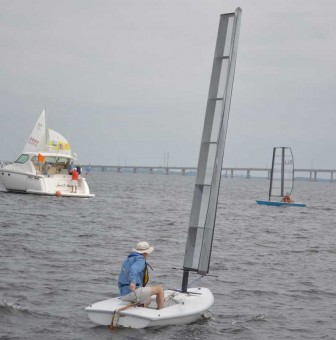
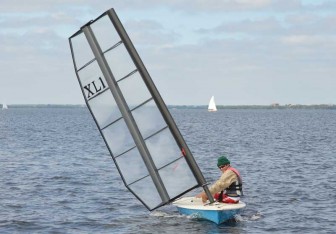
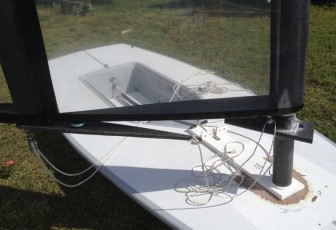
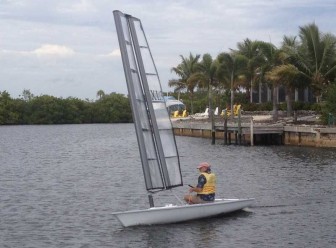
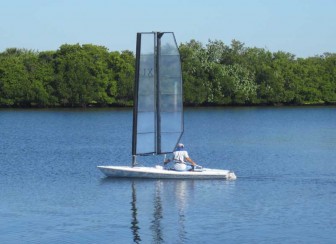
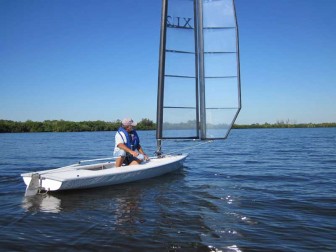
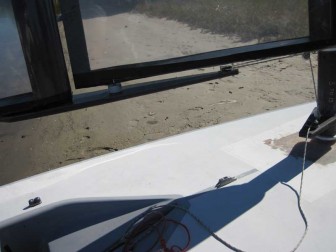
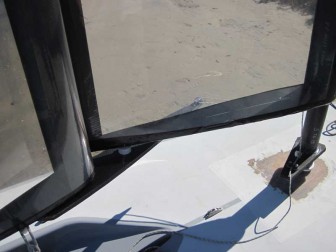
Leave a Reply
You must be logged in to post a comment.